#crossmodal plasticity
Explore tagged Tumblr posts
Text
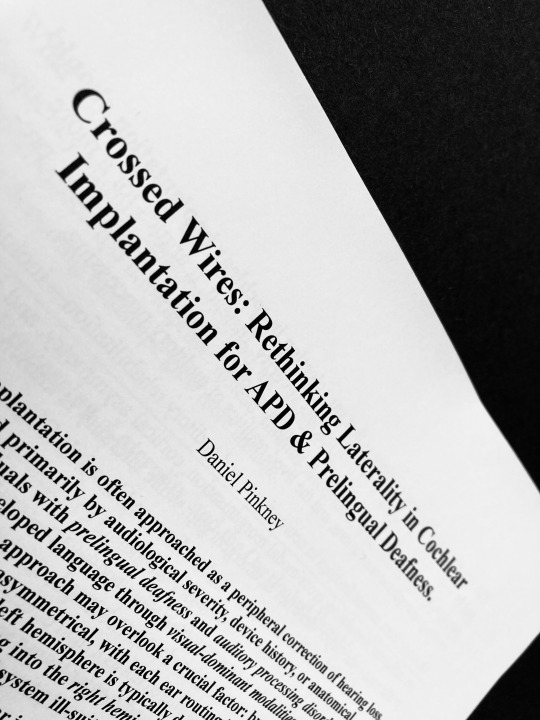
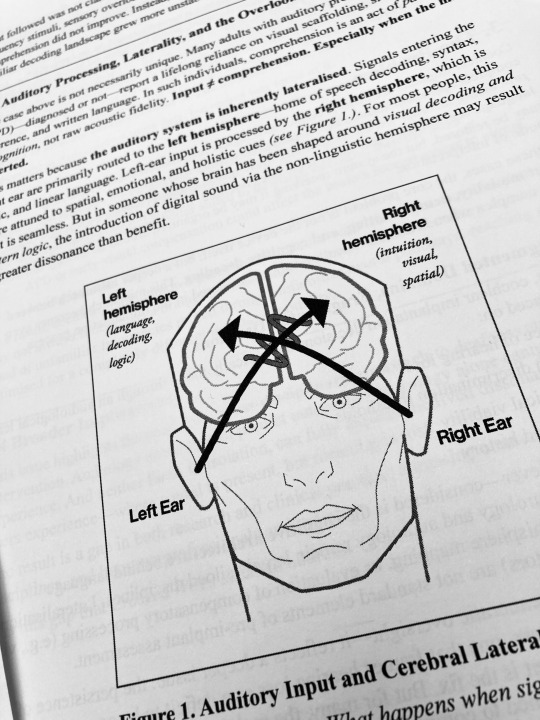
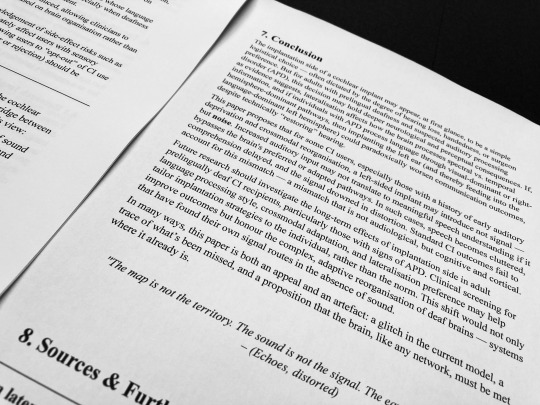
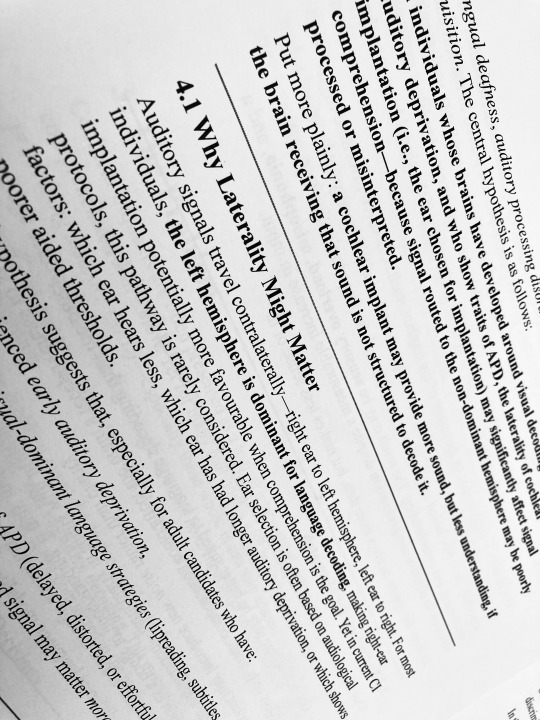
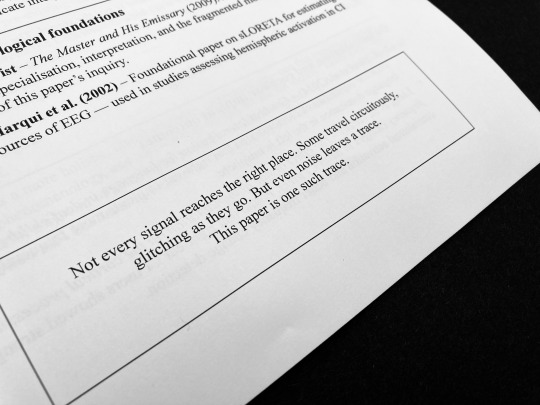
Crossed Wires is now live on OSF — an open-access white paper exploring the overlooked impact of hemispheric lateralisation in cochlear implantation for APD and early-onset deafness. 📄 https://osf.io/pwqr7/
Abstract Cochlear implantation is often approached as a peripheral correction of hearing loss, with ear selection guided primarily by audiological severity, device history, or anatomical constraints. Yet for individuals with prelingual deafness and auditory processing disorder (APD)—particularly those who developed language through visual-dominant modalities such as lipreading and captioning—this approach may overlook a crucial factor: brain lateralisation.
The auditory system is inherently asymmetrical, with each ear routing input to the opposite cerebral hemisphere. Given that the left hemisphere is typically dominant for language decoding, implanting the left ear (feeding into the right hemisphere) may, in some cases, introduce an artificial signal into a neural system ill-suited to interpret it.
This paper proposes that ear choice in cochlear implantation should consider cerebral dominance and sensory compensation history, particularly in older CI recipients with entrenched APD and visual adaptation. Drawing on findings from research on hemispheric language dominance, cortical reorganisation, unilateral vs bilateral stimulation, and cross-modal plasticity, it identifies a critical gap: current CI evaluation protocols rarely account for how early sensory deprivation and neural re-routing shape long-term comprehension.
Evidence suggests CI outcomes can vary based on implantation side (Chilosi et al., 2014) and that unilateral implants may lead to asymmetric cortical dominance with lasting consequences (Gordon et al., 2013).
This paper doesn’t prescribe a universal protocol, but calls for a more personalised, neurocognitive framework—one that recognises that more input does not always mean more understanding, especially when the signal enters the wrong side of a rewired brain.
#crossed wires#process zine#signal // noise#white paper#osf#deaf experience#auditory processing disorder#apd#cochlear implant#neurodivergent#brain lateralisation#crossmodal plasticity#visual language#neuroplasticity#signal vs noise#language pathways#personal science#glitch theory#rewired brain
3 notes
·
View notes
Text
Interesting Papers for Week 9, 2025
Dopamine dynamics are dispensable for movement but promote reward responses. Cai, X., Liu, C., Tsutsui-Kimura, I., Lee, J.-H., Guo, C., Banerjee, A., Lee, J., Amo, R., Xie, Y., Patriarchi, T., Li, Y., Watabe-Uchida, M., Uchida, N., & Kaeser, P. S. (2024). Nature, 635(8038), 406–414.
Immigrant birds learn from socially observed differences in payoffs when their environment changes. Chimento, M., Alarcón-Nieto, G., & Aplin, L. M. (2024). PLOS Biology, 22(11), e3002699.
Spatiotemporal integration of contextual and sensory information within the cortical hierarchy in human pain experience. Gim, S., Hong, S.-J., Reynolds Losin, E. A., & Woo, C.-W. (2024).PLOS Biology, 22(11), e3002910.
Predictive learning shapes the representational geometry of the human brain. Greco, A., Moser, J., Preissl, H., & Siegel, M. (2024). Nature Communications, 15, 9670.
Hierarchical behavior control by a single class of interneurons. Huo, J., Xu, T., Liu, Q., Polat, M., Kumar, S., Zhang, X., Leifer, A. M., & Wen, Q. (2024). Proceedings of the National Academy of Sciences, 121(47), e2410789121.
Cognitive Maps for a Non-Euclidean Environment: Path Integration and Spatial Memory on a Sphere. Kim, M., & Doeller, C. F. (2024). Psychological Science, 35(11), 1217–1230.
Approximate planning in spatial search. Kryven, M., Yu, S., Kleiman-Weiner, M., Ullman, T., & Tenenbaum, J. (2024). PLOS Computational Biology, 20(11), e1012582.
Quantifying convergence and consistency. Matiasz, N. J., Wood, J., & Silva, A. J. (2024). European Journal of Neuroscience, 60(10), 6391–6394.
Prior cocaine use diminishes encoding of latent information by orbitofrontal, but not medial, prefrontal ensembles. Mueller, L. E., Konya, C., Sharpe, M. J., Wikenheiser, A. M., & Schoenbaum, G. (2024). Current Biology, 34(22), 5223-5238.e3.
Orbitofrontal Cortex Mediates Sustained Basolateral Amygdala Encoding of Cued Reward-Seeking States. Ottenheimer, D. J., Vitale, K. R., Ambroggi, F., Janak, P. H., & Saunders, B. T. (2024). Journal of Neuroscience, 44(46), e0013242024.
The Role of the Rat Prefrontal Cortex and Sex Differences in Decision-Making. Palmer, J. A., White, S. R., Chavez Lopez, K., & Laubach, M. (2024). Journal of Neuroscience, 44(46), e0550242024.
Pre-existing visual responses in a projection-defined dopamine population explain individual learning trajectories. Pan-Vazquez, A., Sanchez Araujo, Y., McMannon, B., Louka, M., Bandi, A., Haetzel, L., Faulkner, M., Pillow, J. W., Daw, N. D., & Witten, I. B. (2024). Current Biology, 34(22), 5349-5358.e6.
The Role of Stimulus Uncertainty and Curiosity in Attention Control. Prasad, S., & Hommel, B. (2024). Experimental Psychology, 71(3), 135–143.
High-level visual prediction errors in early visual cortex. Richter, D., Kietzmann, T. C., & de Lange, F. P. (2024). PLOS Biology, 22(11), e3002829.
An electrodiffusive network model with multicompartmental neurons and synaptic connections. Sætra, M. J., & Mori, Y. (2024). PLOS Computational Biology, 20(11), e1012114.
Decrease in decision noise from adolescence into adulthood mediates an increase in more sophisticated choice behaviors and performance gain. Scholz, V., Waltmann, M., Herzog, N., Horstmann, A., & Deserno, L. (2024). PLOS Biology, 22(11), e3002877.
Human-like dissociations between confidence and accuracy in convolutional neural networks. Shekhar, M., & Rahnev, D. (2024). PLOS Computational Biology, 20(11), e1012578.
Time courses of brain plasticity underpinning visual motion perceptual learning. Song, Y., Wang, Q., & Fang, F. (2024). NeuroImage, 302, 120897.
Predecisional information search adaptively reduces three types of uncertainty. Spektor, M. S., & Wulff, D. U. (2024). Proceedings of the National Academy of Sciences, 121(47), e2311714121.
Crossmodal to unimodal transfer of temporal perceptual learning. Zhao, X.-N., Guan, S.-C., Xiong, Y.-Z., & Yu, C. (2024). Perception, 53(11–12), 753–762.
#neuroscience#science#research#brain science#scientific publications#cognitive science#neurobiology#cognition#psychophysics#computational neuroscience#neural computation#neural networks#neurons
10 notes
·
View notes
Link
Introduction to Crossmodal Plasticity Defining Crossmodal Plasticity Crossmodal plasticity refers to the brain's remarkable ability to reorganize and adapt its functions in response to sensory loss or deprivation. It is a form of neuroplasticity that enables the brain to
0 notes
Photo

Crossmodal perception, crossmodal integration and cross modal plasticity of the human brain are increasingly studied in neuroscience to gain a better understanding of the large-scale and long-term properties of the brain.[2] A related research theme is the study of multisensory perception and multisensory integration. Sound & Music https://en.wikipedia.org/wiki/Crossmodal
0 notes
Text
Drop Your Basic Utensil for a New Experience with a Finger-Shaped Spoon
As far as Emily Post is concerned, eating with your hands is a big no-no. But let’s be real, some of our most delicious and memorable food experiences have often come from this very activity. Eating with your bare hands or sucking your fingers are natural behaviors. We believe it feeds your mind, not just your stomach, by offering a personal connection with your food.
Design studio Michel/Fabian tapped into the sensuality of eating with one’s fingers when developing their genius take on the spoon. The result = Goûte, a teardrop-shaped glass wand designed to eat creamy foods like peanut butter, Nutella, yogurt, or chocolate mousse. Their handcrafted utensil makes the experience of eating creamy foods much more mindful and pleasurable.
Michel/Fabian also collaborated with Oxford University’s Crossmodal Research Laboratory to conduct an experiment testing the effect eating with Goûte can have on flavor perception. Participants reported perceiving the food as tasting significantly better than when eating with a conventional spoon. Some participants even rated the sweetness of the yogurt sample as being sweeter than those eating with a plastic spoon. Lastly, the perceived value of the food went up by 40%.
Goûte can be defined in three ways. Each one below clearly shows how perfect the product name truly is.
goût french |gu| taste or gustation. One of the 5 senses that informs about the molecular properties of food. The sensation of flavor perceived in the mouth on contact with a substance. goutte french |gut| drop (of liquid). A small round or pear-shaped portion of liquid that hangs or falls. goûte french |gut| to taste. “Goûte cela” – “Taste this”.
As for the physical design, the original concept started by 3D printing a scanned finger, and giving it a handle. Then after many failed material trials, they decided to move forward with glass. The versatile material could produce a similar shape to the finger while allowing them to find a balance between tactile qualities, visual aesthetics, and manufacturing capacities. The glass Goûte is made by glass blower Richard Price, in the United Kingdom.
Additionally, they also produced a version in different woods: Pear, Maple and Olive. Their wood is ethically sourced, dry-aged, and hand-turned on a lathe by Dominic Jones, wood artisan in the United Kingdom.
Photos by Joe Sarah.
via http://design-milk.com/
from WordPress https://connorrenwickblog.wordpress.com/2017/04/28/drop-your-basic-utensil-for-a-new-experience-with-a-finger-shaped-spoon/
0 notes
Text
Interesting Papers for Week 52, 2022
Happy Holidays
Gaze-specific motor memories for hand-reaching. Abekawa, N., Ito, S., & Gomi, H. (2022). Current Biology, 32(12), 2747-2753.e6.
Semantic relatedness retroactively boosts memory and promotes memory interdependence across episodes. Antony, J. W., Romero, A., Vierra, A. H., Luenser, R. S., Hawkins, R. D., & Bennion, K. A. (2022). eLife, 11, e72519.
Hyperreactivity to uncertainty is a key feature of subjective cognitive impairment. Attaallah, B., Petitet, P., Slavkova, E., Turner, V., Saleh, Y., Manohar, S. G., & Husain, M. (2022). eLife, 11, e75834.
Spontaneous Alpha-Band Oscillations Bias Subjective Contrast Perception. Balestrieri, E., & Busch, N. A. (2022). Journal of Neuroscience, 42(25), 5058–5069.
Dynamical differential covariance recovers directional network structure in multiscale neural systems. Chen, Y., Rosen, B. Q., & Sejnowski, T. J. (2022). Proceedings of the National Academy of Sciences, 119(24), e2117234119.
Spontaneous neuronal oscillations in the human insula are hierarchically organized traveling waves. Das, A., Myers, J., Mathura, R., Shofty, B., Metzger, B. A., Bijanki, K., … Sheth, S. A. (2022). eLife, 11, e76702.
Inhibitory control of frontal metastability sets the temporal signature of cognition. Fontanier, V., Sarazin, M., Stoll, F. M., Delord, B., & Procyk, E. (2022eLife, 11, e63795.
Neuronal correlates of selective attention and effort in visual area V4 are invariant of motivational context. Ghosh, S., & Maunsell, J. H. R. (2022). Science Advances, 8(23).
Cortical adaptation to sound reverberation. Ivanov, A. Z., King, A. J., Willmore, B. D., Walker, K. M., & Harper, N. S. (2022). eLife, 11, e75090.
Learned temporal statistics guide information seeking and shape memory. Lang, E. A., van Geen, C., Tedeschi, E., Marvin, C. B., & Shohamy, D. (2022). Journal of Experimental Psychology: General, 151(5), 986–995.
Distinct representation of cue-outcome association by D1 and D2 neurons in the ventral striatum’s olfactory tubercle. Martiros, N., Kapoor, V., Kim, S. E., & Murthy, V. N. (2022)eLife, 11, e75463.
Early beta oscillations in multisensory association areas underlie crossmodal performance enhancement. Michail, G., Senkowski, D., Holtkamp, M., Wächter, B., & Keil, J. (2022). NeuroImage, 257, 119307.
Perceptual enhancement and suppression correlate with V1 neural activity during active sensing. Niemeyer, J. E., Akers-Campbell, S., Gregoire, A., & Paradiso, M. A. (2022). Current Biology, 32(12), 2654-2667.e4.
Multiple timescales of sensory-evidence accumulation across the dorsal cortex. Pinto, L., Tank, D. W., & Brody, C. D. (2022). eLife, 11, e70263.
Signatures of rapid plasticity in hippocampal CA1 representations during novel experiences. Priestley, J. B., Bowler, J. C., Rolotti, S. V., Fusi, S., & Losonczy, A. (2022). Neuron, 110(12), 1978-1992.e6.
A predictive coding account of value-based learning in PTSD: Implications for precision treatments. Putica, A., Felmingham, K. L., Garrido, M. I., O’Donnell, M. L., & Van Dam, N. T. (2022). Neuroscience & Biobehavioral Reviews, 138, 104704.
Specializations in optic flow encoding in the pretectum of hummingbirds and zebra finches. Smyth, G., Baliga, V. B., Gaede, A. H., Wylie, D. R., & Altshuler, D. L. (2022). Current Biology, 32(12), 2772-2779.e4.
Guidance of attention from visual working memory is feature-based, not object-based: Implications for models of feature binding. Thayer, D. D., Bahle, B., & Hollingworth, A. (2022). Journal of Experimental Psychology: General, 151(5), 1018–1034.
Severe distortion in the representation of foveal visual image locations in short-term memory. Willeke, K. F., Cardenas, A. R., Bellet, J., & Hafed, Z. M. (2022). Proceedings of the National Academy of Sciences, 119(24), e2121860119.
Children with ASD establish joint attention during free-flowing toy play without face looks. Yurkovic-Harding, J., Lisandrelli, G., Shaffer, R. C., Dominick, K. C., Pedapati, E. V., Erickson, C. A., … Kennedy, D. P. (2022). Current Biology, 32(12), 2739-2746.e4.
#science#Neuroscience#computational neuroscience#Brain science#research#cognition#neurons#cognitive science#psychophysics#neural networks#neural computation#neurobiology#scientific publications
9 notes
·
View notes
Text
Interesting Papers for Week 5, 2021
The expected prisoner’s dilemma – With rationally arising cooperation. Arend, R. J. (2020). PLOS ONE, 15(9), e0239299.
Nonlinear stimulus representations in neural circuits with approximate excitatory-inhibitory balance. Baker, C., Zhu, V., & Rosenbaum, R. (2020). PLOS Computational Biology, 16(9), e1008192.
Domino-like transient dynamics at seizure onset in epilepsy. Creaser, J., Lin, C., Ridler, T., Brown, J. T., D’Souza, W., Seneviratne, U., … Tsaneva-Atanasova, K. (2020). PLOS Computational Biology, 16(9), e1008206.
Short-term depression and long-term plasticity together tune sensitive range of synaptic plasticity. Deperrois, N., & Graupner, M. (2020). PLOS Computational Biology, 16(9), e1008265.
A map of decoy influence in human multialternative choice. Dumbalska, T., Li, V., Tsetsos, K., & Summerfield, C. (2020). Proceedings of the National Academy of Sciences of the United States of America, 117(40), 25169–25178.
Generation of Sharp Wave-Ripple Events by Disinhibition. Evangelista, R., Cano, G., Cooper, C., Schmitz, D., Maier, N., & Kempter, R. (2020). Journal of Neuroscience, 40(41), 7811–7836.
A whole-brain connectivity map of mouse insular cortex. Gehrlach, D. A., Weiand, C., Gaitanos, T. N., Cho, E., Klein, A. S., Hennrich, A. A., … Gogolla, N. (2020). eLife, 9, e55585.
Direction-selective motion discrimination by traveling waves in visual cortex. Heitmann, S., & Ermentrout, G. B. (2020). PLOS Computational Biology, 16(9), e1008164.
Therapeutic effects of anodal transcranial direct current stimulation in a rat model of ADHD. Jung, D. H., Ahn, S. M., Pak, M. E., Lee, H. J., Jung, Y. J., Kim, K. B., … Choi, B. T. (2020). eLife, 9, e56359.
Tuning network dynamics from criticality to an asynchronous state. Li, J., & Shew, W. L. (2020). PLOS Computational Biology, 16(9), e1008268.
Learning probabilistic neural representations with randomly connected circuits. Maoz, O., Tkačik, G., Esteki, M. S., Kiani, R., & Schneidman, E. (2020). Proceedings of the National Academy of Sciences of the United States of America, 117(40), 25066–25073.
Relations between large-scale brain connectivity and effects of regional stimulation depend on collective dynamical state. Papadopoulos, L., Lynn, C. W., Battaglia, D., & Bassett, D. S. (2020). PLOS Computational Biology, 16(9), e1008144.
Saccadic adaptation shapes perceived size: Common codes for action and perception. Pressigout, A., Paeye, C., & Doré-Mazars, K. (2020). Attention, Perception, & Psychophysics, 82(7), 3676–3685.
Response nonlinearities in networks of spiking neurons. Sanzeni, A., Histed, M. H., & Brunel, N. (2020). PLOS Computational Biology, 16(9), e1008165.
New insights on the modeling of the molecular mechanisms underlying neural maps alignment in the midbrain. Savier, E. L., Dunbar, J., Cheung, K., & Reber, M. (2020). eLife, 9, e59754.
Reward foraging task and model-based analysis reveal how fruit flies learn value of available options. Seidenbecher, S. E., Sanders, J. I., von Philipsborn, A. C., & Kvitsiani, D. (2020). PLOS ONE, 15(10), e0239616.
Crossmodal associations modulate multisensory spatial integration. Tong, J., Li, L., Bruns, P., & Röder, B. (2020). Attention, Perception, & Psychophysics, 82(7), 3490–3506.
A comparison of neuronal population dynamics measured with calcium imaging and electrophysiology. Wei, Z., Lin, B.-J., Chen, T.-W., Daie, K., Svoboda, K., & Druckmann, S. (2020). PLOS Computational Biology, 16(9), e1008198.
Similarities and differences in spatial and non-spatial cognitive maps. Wu, C. M., Schulz, E., Garvert, M. M., Meder, B., & Schuck, N. W. (2020). PLOS Computational Biology, 16(9), e1008149.
Efficient sensory coding of multidimensional stimuli. Yerxa, T. E., Kee, E., DeWeese, M. R., & Cooper, E. A. (2020). PLOS Computational Biology, 16(9), e1008146.
#science#Neuroscience#computational neuroscience#Brain science#research#neurobiology#neurons#cognition#cognitive science#psychophysics#scientific publications
2 notes
·
View notes
Text
Interesting Papers for Week 28, 2020
Visual illusions via neural dynamics: Wilson–Cowan-type models and the efficient representation principle. Bertalmío, M., Calatroni, L., Franceschi, V., Franceschiello, B., Gomez Villa, A., & Prandi, D. (2020). Journal of Neurophysiology, 123(5), 1606–1618.
Inferring an unobservable population size from observable samples. Cao, J., & Banaji, M. R. (2020). Memory & Cognition, 48(3), 348–360.
Reward-Based Improvements in Motor Control Are Driven by Multiple Error-Reducing Mechanisms. Codol, O., Holland, P. J., Manohar, S. G., & Galea, J. M. (2020). Journal of Neuroscience, 40(18), 3604–3620.
Molecular Mechanisms in Hippocampus Involved on Object Recognition Memory Consolidation and Reconsolidation. Furini, C. R. G., Nachtigall, E. G., Behling, J. A. K., Assis Brasil, E. S., Saenger, B. F., Narvaes, R. F., … Izquierdo, I. (2020). Neuroscience, 435, 112–123.
Ultralow-frequency neural entrainment to pain. Guo, Y., Bufacchi, R. J., Novembre, G., Kilintari, M., Moayedi, M., Hu, L., & Iannetti, G. D. (2020). PLOS Biology, 18(4), e3000491.
Stimulus salience determines defensive behaviors elicited by aversively conditioned serial compound auditory stimuli. Hersman, S., Allen, D., Hashimoto, M., Brito, S. I., & Anthony, T. E. (2020). eLife, 9, e53803.
Interhemispheric connections between olfactory bulbs improve odor detection. Kermen, F., Lal, P., Faturos, N. G., & Yaksi, E. (2020). PLOS Biology, 18(4), e3000701.
Gamma-band correlations in the primary visual cortex. Liu, X., Sanz-Leon, P., & Robinson, P. A. (2020). Physical Review E, 101(4), 042406.
The Firing of Theta State-Related Septal Cholinergic Neurons Disrupt Hippocampal Ripple Oscillations via Muscarinic Receptors. Ma, X., Zhang, Y., Wang, L., Li, N., Barkai, E., Zhang, X., … Xu, J. (2020). Journal of Neuroscience, 40(18), 3591–3603.
Vision and Locomotion Combine to Drive Path Integration Sequences in Mouse Retrosplenial Cortex. Mao, D., Molina, L. A., Bonin, V., & McNaughton, B. L. (2020). Current Biology, 30(9), 1680-1688.e4.
Animal affect and decision-making. Mendl, M., & Paul, E. S. (2020). Neuroscience & Biobehavioral Reviews, 112, 144–163.
Causal Evidence for a Role of Theta and Alpha Oscillations in the Control of Working Memory. Riddle, J., Scimeca, J. M., Cellier, D., Dhanani, S., & D’Esposito, M. (2020). Current Biology, 30(9), 1748-1754.e4.
Multisensory Integration Develops Prior to Crossmodal Recalibration. Rohlf, S., Li, L., Bruns, P., & Röder, B. (2020). Current Biology, 30(9), 1726-1732.e7.
Progressive alignment of inhibitory and excitatory delay may drive a rapid developmental switch in cortical network dynamics. Romagnoni, A., Colonnese, M. T., Touboul, J. D., & Gutkin, B. S. (2020). Journal of Neurophysiology, 123(5), 1583–1599.
Mesoscopic population equations for spiking neural networks with synaptic short-term plasticity. Schmutz, V., Gerstner, W., & Schwalger, T. (2020). Journal of Mathematical Neuroscience, 10(1), 5.
Mapping Cortical Integration of Sensory and Affective Pain Pathways. Singh, A., Patel, D., Li, A., Hu, L., Zhang, Q., Liu, Y., … Wang, J. (2020). Current Biology, 30(9), 1703-1715.e5.
Temporal Sharpening of Sensory Responses by Layer V in the Mouse Primary Somatosensory Cortex. Vecchia, D., Beltramo, R., Vallone, F., Chéreau, R., Forli, A., Molano-Mazón, M., … Fellin, T. (2020). Current Biology, 30(9), 1589-1599.e10.
BigBrain 3D atlas of cortical layers: Cortical and laminar thickness gradients diverge in sensory and motor cortices. Wagstyl, K., Larocque, S., Cucurull, G., Lepage, C., Cohen, J. P., Bludau, S., … Evans, A. C. (2020). PLOS Biology, 18(4), e3000678.
Dynamics and Hierarchical Encoding of Non-compact Acoustic Categories in Auditory and Frontal Cortex. Yin, P., Strait, D. L., Radtke-Schuller, S., Fritz, J. B., & Shamma, S. A. (2020). Current Biology, 30(9), 1649-1663.e5.
Understanding collective behaviors in reinforcement learning evolutionary games via a belief-based formalization. Zhang, J.-Q., Zhang, S.-P., Chen, L., & Liu, X.-D. (2020). Physical Review E, 101(4), 042402.
#science#Neuroscience#computational neuroscience#Brain science#research#neurobiology#cognition#cognitive science#psychophysics#scientific publications
1 note
·
View note
Text
Interesting Papers for Week 40, 2019
Cell-Type-Specific D1 Dopamine Receptor Modulation of Projection Neurons and Interneurons in the Prefrontal Cortex. Anastasiades, P. G., Boada, C., & Carter, A. G. (2019). Cerebral Cortex, 29(7), 3224–3242.
Rapid Plasticity of Higher-Order Thalamocortical Inputs during Sensory Learning. Audette, N. J., Bernhard, S. M., Ray, A., Stewart, L. T., & Barth, A. L. (2019). Neuron, 103(2), 277-291.e4.
Widespread and Highly Correlated Somato-dendritic Activity in Cortical Layer 5 Neurons. Beaulieu-Laroche, L., Toloza, E. H. S., Brown, N. J., & Harnett, M. T. (2019). Neuron, 103(2), 235-241.e4.
A quantitative model of conserved macroscopic dynamics predicts future motor commands. Brennan, C., & Proekt, A. (2019). eLife, 8, e46814.
Songbird Ventral Pallidum Sends Diverse Performance Error Signals to Dopaminergic Midbrain. Chen, R., Puzerey, P. A., Roeser, A. C., Riccelli, T. E., Podury, A., Maher, K., … Goldberg, J. H. (2019). Neuron, 103(2), 266-276.e4.
Multimodal cue integration in the dung beetle compass. Dacke, M., Bell, A. T. A., Foster, J. J., Baird, E. J., Strube-Bloss, M. F., Byrne, M. J., & El Jundi, B. (2019). Proceedings of the National Academy of Sciences of the United States of America, 116(28), 14248–14253.
Mental Imagery Follows Similar Cortical Reorganization as Perception: Intra-Modal and Cross-Modal Plasticity in Congenitally Blind. de Borst, A. W., & de Gelder, B. (2019). Cerebral Cortex, 29(7), 2859–2875.
Cascaded Tuning to Amplitude Modulation for Natural Sound Recognition. Koumura, T., Terashima, H., & Furukawa, S. (2019). Journal of Neuroscience, 39(28), 5517–5533.
A sense of space in postrhinal cortex. LaChance, P. A., Todd, T. P., & Taube, J. S. (2019). Science , 365(6449), eaax4192.
Synaptic Mechanisms for Bandwidth Tuning in Awake Mouse Primary Auditory Cortex. Li, H., Liang, F., Zhong, W., Yan, L., Mesik, L., Xiao, Z., … Zhang, L. I. (2019). Cerebral Cortex, 29(7), 2998–3009.
Prefrontal Control Over Occipital Responses to Crossmodal Overlap Varies Across the Congruency Spectrum. Lundström, J. N., Regenbogen, C., Ohla, K., & Seubert, J. (2019). Cerebral Cortex, 29(7), 3023–3033.
Neuronal Effects of Spatial and Feature Attention Differ Due to Normalization. Ni, A. M., & Maunsell, J. H. R. (2019). Journal of Neuroscience, 39(28), 5493–5505.
Laminar segregation of sensory coding and behavioral readout in macaque V4. Pettine, W. W., Steinmetz, N. A., & Moore, T. (2019). Proceedings of the National Academy of Sciences of the United States of America, 116(29), 14749–14754.
Neuronal integration in the adult mouse olfactory bulb is a non-selective addition process. Platel, J.-C., Angelova, A., Bugeon, S., Wallace, J., Ganay, T., Chudotvorova, I., … Cremer, H. (2019). eLife, 8, e44830.
Structured, uncertainty-driven exploration in real-world consumer choice. Schulz, E., Bhui, R., Love, B. C., Brier, B., Todd, M. T., & Gershman, S. J. (2019). Proceedings of the National Academy of Sciences of the United States of America, 116(28), 13903–13908.
Accurate Estimation of Neural Population Dynamics without Spike Sorting. Trautmann, E. M., Stavisky, S. D., Lahiri, S., Ames, K. C., Kaufman, M. T., O’Shea, D. J., … Shenoy, K. V. (2019). Neuron, 103(2), 292-308.e4.
The somatosensory cortex receives information about motor output. Umeda, T., Isa, T., & Nishimura, Y. (2019). Science Advances, 5(7), eaaw5388.
Gaussian Transfer Convolutional Neural Networks. Wang, H., Li, C., Zhen, X., Yang, W., & Zhang, B. (2019). IEEE Transactions on Emerging Topics in Computational Intelligence, 3(5), 360–368.
Active information maintenance in working memory by a sensory cortex. Zhang, X., Yan, W., Wang, W., Fan, H., Hou, R., Chen, Y., … Li, C. T. (2019). eLife, 8, e43191.
Posterior parietal cortex plays a causal role in perceptual and categorical decisions. Zhou, Y., & Freedman, D. J. (2019). Science, 365(6449), 180–185.
#science#Neuroscience#computational neuroscience#Brain science#research#cognition#cognitive science#neurobiology#psychophysics#scientific publications#neural networks
3 notes
·
View notes
Text
Interesting Papers for Week 39, 2018
Synapse-specific representation of the identity of overlapping memory engrams. Abdou, K., Shehata, M., Choko, K., Nishizono, H., Matsuo, M., Muramatsu, S.-I., & Inokuchi, K. (2018). Science, 360(6394), 1227–1231.
Disentangling the visual, motor and representational effects of vestibular input. Abekawa, N., Ferrè, E. R., Gallagher, M., Gomi, H., & Haggard, P. (2018). Cortex, 104, 46–57.
Approach motivation in human cerebral cortex. Brookshire, G., & Casasanto, D. (2018). Philosophical Transactions of the Royal Society B: Biological Sciences, 373(1752), 20170141.
Foveal Crowding Resolved. Coates, D. R., Levi, D. M., Touch, P., & Sabesan, R. (2018). Scientific Reports, 8, 9177.
Roles of the right temporo-parietal and premotor cortices in self-location and body ownership. Convento, S., Romano, D., Maravita, A., & Bolognini, N. (2018). European Journal of Neuroscience, 47(11), 1289–1302.
Equal kinematics and visual context but different purposes: Observer’s moral rules modulate motor resonance. Craighero, L., & Mele, S. (2018). Cortex, 104, 1–11.
Striatal action-value neurons reconsidered. Elber-Dorozko, L., & Loewenstein, Y. (2018). eLife, 7, e34248.
Neural scene representation and rendering. Eslami, S. M. A., Jimenez Rezende, D., Besse, F., Viola, F., Morcos, A. S., Garnelo, M., … Hassabis, D. (2018). Science, 360(6394), 1204–1210.
Cardio-visual full body illusion alters bodily self-consciousness and tactile processing in somatosensory cortex. Heydrich, L., Aspell, J. E., Marillier, G., Lavanchy, T., Herbelin, B., & Blanke, O. (2018). Scientific Reports, 8, 9230.
Sensory attenuation of self-produced signals does not rely on self-specific motor predictions. Kaiser, J., & Schütz-Bosbach, S. (2018). European Journal of Neuroscience, 47(11), 1303–1310.
Reactivation of recall-induced neurons contributes to remote fear memory attenuation. Khalaf, O., Resch, S., Dixsaut, L., Gorden, V., Glauser, L., & Gräff, J. (2018). Science, 360(6394), 1239–1242.
A Quadrantic Bias in Prefrontal Representation of Visual-Mnemonic Space. Leavitt, M. L., Pieper, F., Sachs, A. J., & Martinez-Trujillo, J. C. (2018). Cerebral Cortex, 28(7), 2405–2421.
Neural Coding of Cell Assemblies via Spike-Timing Self-Information. Li, M., Xie, K., Kuang, H., Liu, J., Wang, D., Fox, G. E., … Tsien, J. Z. (2018). Cerebral Cortex, 28(7), 2563–2576.
Social perception of others shapes one’s own multisensory peripersonal space. Pellencin, E., Paladino, M. P., Herbelin, B., & Serino, A. (2018). Cortex, 104, 163–179.
Aging and the Visual Perception of Motion Direction: Solving the Aperture Problem. Shain, L. M., & Norman, J. F. (2018). Perception, 47(7), 735–750.
Cross-modal restoration of ocular dominance plasticity in adult mice. Teichert, M., Isstas, M., Zhang, Y., & Bolz, J. (2018). European Journal of Neuroscience, 47(11), 1375–1384.
Crossmodal association of auditory and visual material properties in infants. Ujiie, Y., Yamashita, W., Fujisaki, W., Kanazawa, S., & Yamaguchi, M. K. (2018). Scientific Reports, 8, 9301.
Atypical Endocannabinoid Signaling Initiates a New Form of Memory-Related Plasticity at a Cortical Input to Hippocampus. Wang, W., Jia, Y., Pham, D. T., Palmer, L. C., Jung, K.-M., Cox, C. D., … Lynch, G. (2018). Cerebral Cortex, 28(7), 2253–2266.
Developmental deprivation-induced perceptual and cortical processing deficits in awake-behaving animals. Yao, J. D., & Sanes, D. H. (2018). eLife, 7, e33891.
Neural network models of the tactile system develop first-order units with spatially complex receptive fields. Zhao, C. W., Daley, M. J., & Pruszynski, J. A. (2018). PLOS ONE, 13(6), e0199196.
#science#Neuroscience#neurobiology#cognition#computational neuroscience#cognitive science#research#scientific publications#Brain science#machine learning#psychophysics
5 notes
·
View notes